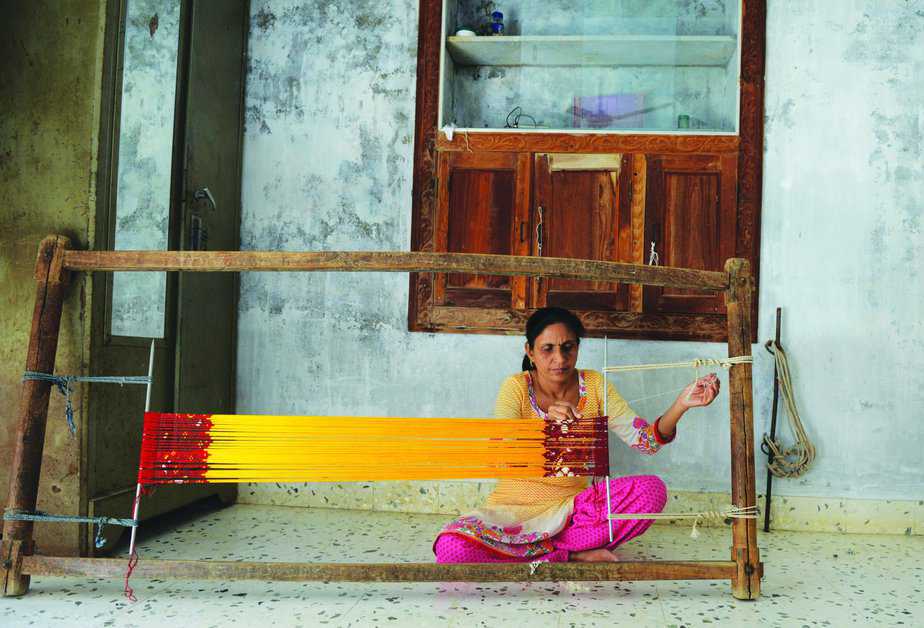
Jagrutiben Salvi weaves silk threads for a 'Patola Saree' at a workshop in Patan
When they collaborate with Indian designers, great products are produced for export but meagre wages are given to those who have honed their craft to the point where it can only be called exquisite. For millennials, the current craze is Fabindia or Ruchika Sachdev’s winning collection at recently concluded Woolmark Competition. The world is ready for Indian dexterity.
We all know how khadi is identified with Mahatma Gandhi. His announcement of Swadeshi movement transformed khadi into a unifying factor in the struggle for independence.
Himanshu Shani (creative director of 11.11, a fashion label based in New Delhi) told Patriot, “Khadi for me is a philosophy about how and who makes a product. A textile made of natural fibre that is handspun, hand-woven, without utilising any industrial setup; it is like meditation.” For him it is the beauty and celebration of every small detail and work that goes into the making of what is purely ‘handmade’.
Korra jeans and 11.11 write the craftsperson’s name on each outfit made by them. 11.11 is also creating a database about them. When a shopper is looking for an outfit to buy, s/he can find all the details online about the person who made it.
Craft in India has come a long way. The jhola clan is now dressed in ethnic chic. There are more marketplaces, online or offline, for us to splurge on objects that are the result of long hours of painstaking work. There are fashion labels, cooperatives, academic institutes, NGOs and various ministries that have integrated the production of craft with design and latest trends to make it relevant for today’s day and age.
Perhaps, it is the craft’s sustainability that needs to be the real conversation. Are we as a society doing enough to protect our own interest in crafts for us to keep supporting it in years to come? Can we assure those who have honed their skills through hours of intense craftsmanship, supporting their families, that we the next generation can be safely inducted into carrying on the same tradition?
One of the crucial discussions is that of the artisan’s enthusiasm for their ouevre, which largely depends on the money they earn and the lifestyle it can support. India has been slotted as an inexpensive manufacturing hub for various International fashion labels. But the craft that makes those designs so vibrant comes with years of heritage and traditional folklore that needs to be adequately rewarded.
For these statistics to keep getting better, rights of the craftspersons, many of whom are women working from home, need to be taken into consideration. While most of the craft societies produce for bigger brands, who receive maximum returns. According to a report under an ongoing project Ustad, conducted by the minorities ministry, traditional rug weavers living in Dharamshala are mostly women, who work for more than eight hours a day and earn upto Rs 5,000 every month to support their families. The craftsmen generally accept what is offered to them and are unaware of the whole export game.
Delhi Haat offers one such system where the craftspersons personally present their products to the customer but bureaucratic procedures are a big factor that prevent everyone getting a space there. Brands like Fabindia have managed to create an elaborate enterprise out of Indian crafts but their artisans living in villages who work with suppliers and middlemen end up earning the bare minimum. Even the skilled workers in factories of export and fashion houses in metropolitan cities who do the most intricate hand embroidery manage to only survive on what they get paid.
In such a scenario, where are we heading as a society with the most diverse cultures and crafts to support it? It is time to examine the institutional structures and finetune labour laws to benefit craftspersons. What can private and government bodies can do to uplift their lives and meet their ambitions? The involvement of craftspersons as equal partners in the production and marketing of crafts could be one way. Another would be in determining the government policy towards crafts.
Only the right interventions will save our traditions from being consigned to the dustbin of history.
Delhi Police raided a late-night illegal bar in Samaypur Badli, detaining 25 people and seizing…
A rear-end crash near Delhi Haat triggered a blaze that gutted both vehicles, though no…
Court grants probe agency more time as NIA pursues wider links in Red Fort blast…
Featuring works in thread, fabric, performance and digital media, Ski(e)n examines the body as a…
Govt report shows gains in maternal health, with better care access and fewer anaemia cases…
Delhi driver murdered after petty dispute; birthday celebration turns violent, say police